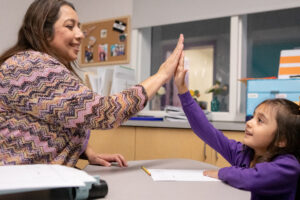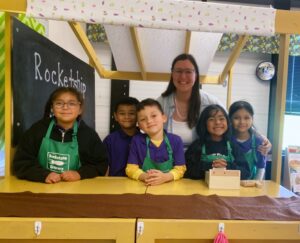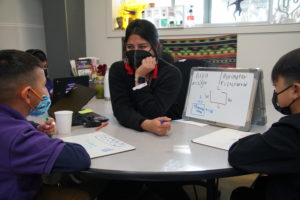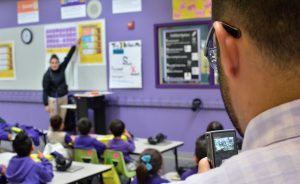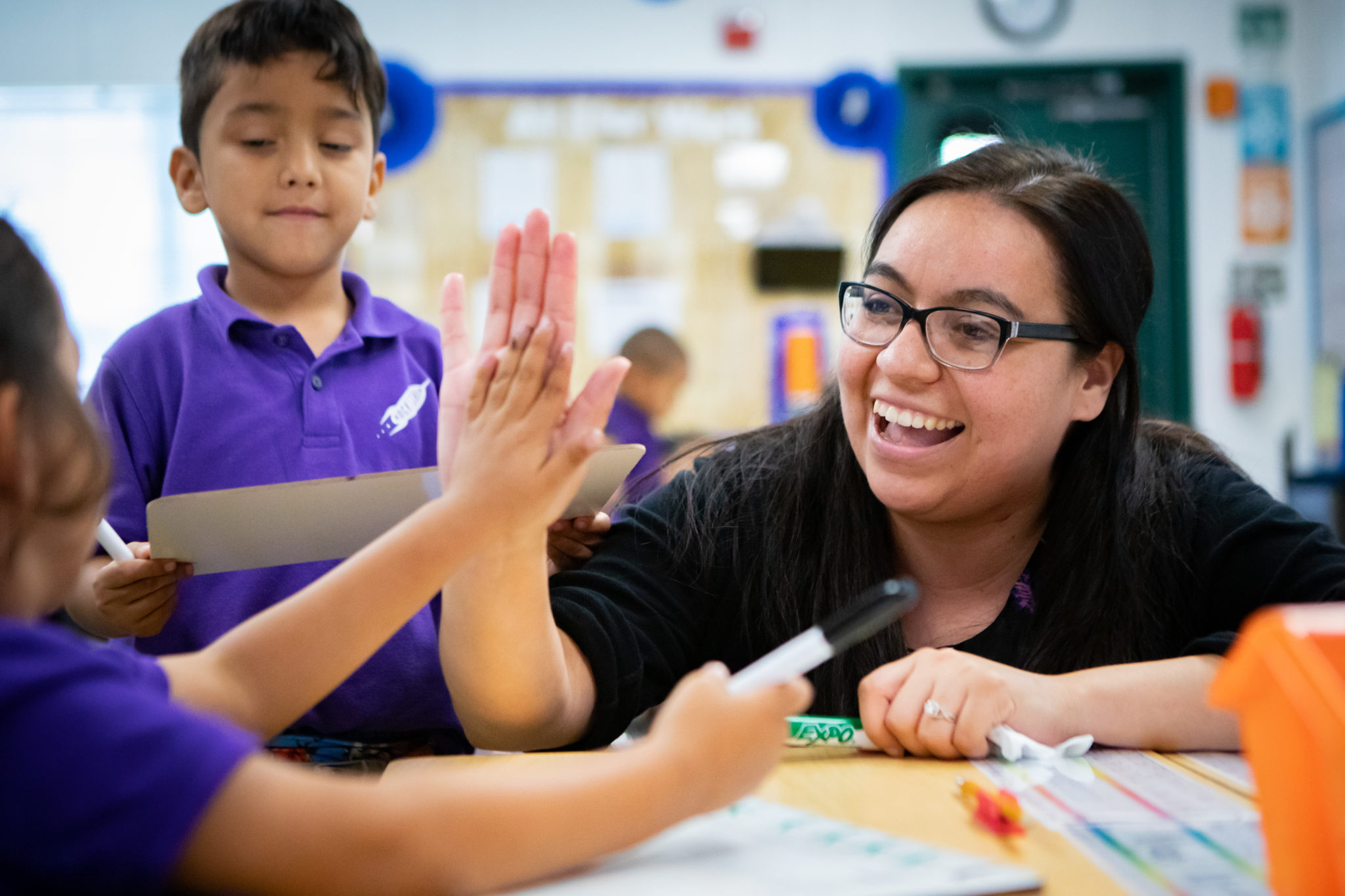
What Makes a Strong Culturally-Responsive Pedagogy
Whether it’s your first year teaching elementary school or your first time teaching at Rocketship, you may be wondering what key things you need to know to start strong on day one. Before you know what you’re going to teach, you need to know how you’re going to teach it – the theory and practice of educating, otherwise known as pedagogy.
At Rocketship Public Schools, we’ve built our curriculum and school culture around a culturally-responsive pedagogy. This means that our curriculum designers, teachers, and leaders are all consciously aware of the different identities they inhabit, the identities and experiences their students bring into the classroom, and work to honor and recognize the intersection of those experiences through the curriculum.
Culturally Responsive Pedagogy/Teaching (often utilizing the acronym CRT) is not only a critical examination of what is being taught but also a deeper exploration of how that content is presented for students. This particular method is effective because it honors students’ experiences and identities, deconstructs stereotypes, and the negative impacts of schooling on traditionally underrepresented groups. It also creates an environment that is both academically and culturally rich and shows students that you can intersect strong, rigorous academic work with cultural values.
If you’re teaching at a school that has a similar approach, follow along to discover the key pillars of a culturally responsive pedagogy and what this looks like in the classroom.
1. Teach With Students At The Center
Giving students choices and agency in their academic work is a key engagement strategy, and allows the teacher, regardless of age, to serve as a “facilitator” for student learning. Giving choice and serving as a guide to course-correct as needed puts the mental “heavy lifting” on the student, and reinforces a rigorous application of course content. Watch this video to see an example.
2. Provide Multiple Opportunities for Practice & Mastery
There is a popular cartoon that depicts different animals lined up in front of a tree with a seated narrator saying: “For a fair selection everybody has to take the same exam: please climb that tree.” While the monkey is smiling at that type of exam, the goldfish and elephant are drawn with mouth-agape astonishment. In today’s educational climate, our students are often exposed to the exact same methods of learning and assessment, but we know they have incredibly diverse strengths and experiences. Think about the multiple ways to assess learning and mastery in your classroom, and see how different techniques can bring out different skills in your students.
3. Examine Your Curriculum
Taking the time to work with curriculum developers and think through the dynamics of pedagogy, representation, and relevance are the collective responsibilities of all educators. Giving students chances to see themselves in their learning and derive meaning from complex tasks that are thought-provoking are hallmarks of great teaching. When teachers focus on the students’ personal experiences, learners are able to make connections between their own lives and academic worlds. Watch this video for an example.
4. Partner With Parents
As educators, forming deep connections with parents and the broader community can have many positive effects. It can engender trust, improve communication, and result in higher academic achievement for students. At Rocketship, we pride ourselves on the strong bond we form with families, and we provide ample opportunities for our families to collaborate and directly participate in their child’s education. To be effective, we understand that the stronger the partnership between home and school, the more connected our students will feel at school. Utilize any and all opportunities to include families in the work of your school and classroom! This can include annual home visits to get to know each family before the year begins. You can also text or email parents when their child excelled in class that day or could use extra support. School administrators can also consider increasing the frequency of parent-teacher conferences to ensure educators are having in-depth touchpoints with each family throughout the year. Watch the below video to hear a parent’s perspective.
5. Communicate High Expectations
In research conducted by Linda-Darling Hammond (2001), considered by many to be one of the foremost authorities on Culturally Responsive Pedagogy, she finds that students of color are not only given inadequate and unequal resources, but the actual quality of the education they receive is not as rigorous. In teaching students, it is critically important to communicate the idea that all students can be successful, and be super clear and proactive in communicating your goals for students. In both short-term and long-term settings, being thoughtful about the way you communicate and offering specific guidance for tasks and goals communicates the high bar you are setting in your classroom. Watch this video for an example.
Source(s):
Smedley BD, Stith AY, Colburn L, et al.; Institute of Medicine (US). The Right Thing to Do, The Smart Thing to Do: Enhancing Diversity in the Health Professions: Summary of the Symposium on Diversity in Health Professions in Honor of Herbert W.Nickens, M.D.. Washington (DC): National Academies Press (US); 2001. Inequality in Teaching and Schooling: How Opportunity Is Rationed to Students of Color in America.
Published on September 26, 2020
Read more stories about: Uncategorized.
In the Classroom
Parent Conference Tips for First Year Teachers
Jeremiah David, Paraprofessional, Rocketship Dream Community Prep | January 6, 2025
Looking for top parent conference tips? Prepare with advice from our educators.
Read more ⟩First Year Teacher? Here are Five Mistakes to Avoid.
Jeremiah David, Paraprofessional, Rocketship Dream Community Prep | November 1, 2024
See what mistakes most first year teachers make and how you can get ahead this school year with some simple tips from a fellow educator.
Read more ⟩3 Classroom Systems New Teachers Swear By
Rocketship Public Schools | Sept. 30, 2024
As a first year teacher, establishing a smooth and productive classroom environment can feel a tad overwhelming. Thankfully, these simple strategies can go a long way.
Read more ⟩How Co-Teacher Collaboration Can Benefit Your Classroom
Featuring Alejandra Chavez, Education Specialist at Rocketship Mosaic Elementary | June 10, 2024
Hear from Ms. Aly about how a small team of educators can make a big difference in student outcomes through thoughtful planning, focused collaboration, and personalized accommodations. Ms. Aly was one of our highest-performing educators in California for the 23-24 school year.
Read more ⟩How to Spark Joy in ESL Classrooms with a Multilingual Learning Clubhouse
Featuring Ms. Amy De La Rosa, Multilingual Specialist, Nashville Northeast Elementary | June 1, 2023
Listen in to an audio interview with Amy De La Rosa, a Multilingual Specialist who has worked as an educator for over 14 years and found an innovative way to help her students learn English in a more accelerated, playful way.
Read more ⟩Supporting Parents of Multilingual Students in Family/Teacher Conferences
Emma Volpe, Rocketship United Academy | June 1, 2022
Get thoughtful insight on how to create a more inclusive family-teacher conference environment.
Read more ⟩5 Ways to Strengthen Relationships in the Classroom
James Cross, Assistant Principal, Rocketship Nashville Northeast Elementary | February 20, 2022
A new age of education calls for a new level of connection. Here are some key tips to strengthen relationships in your classroom this school year.
Read more ⟩5 Ways School Leaders Can Coach and Support Teachers
Eesir Kaur, Director of Professional Development | October 15, 2020
Are you a school leader looking to coach your teachers more effectively? Here's what works for us.
Read more ⟩




